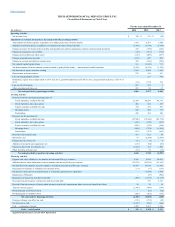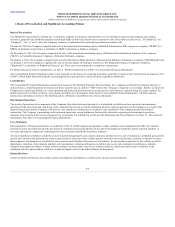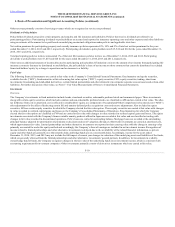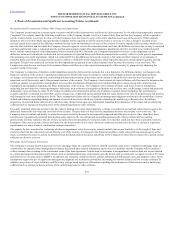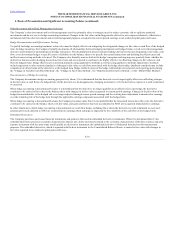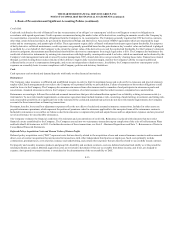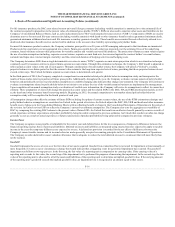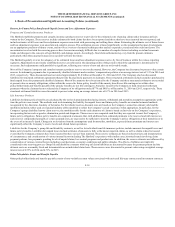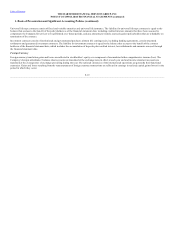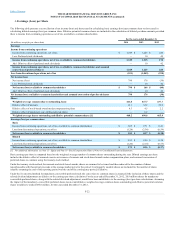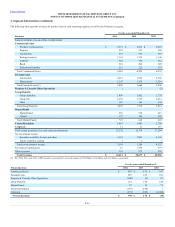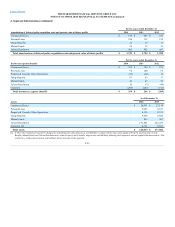The Hartford 2014 Annual Report Download - page 150
Download and view the complete annual report
Please find page 150 of the 2014 The Hartford annual report below. You can navigate through the pages in the report by either clicking on the pages listed below, or by using the keyword search tool below to find specific information within the annual report.
Table of Contents
Credit Risk
Credit risk is defined as the risk of financial loss due to uncertainty of an obligor’s or counterparty’s ability or willingness to meet its obligations in
accordance with agreed upon terms. Credit exposures are measured using the market value of the derivatives, resulting in amounts owed to the Company by
its counterparties or potential payment obligations from the Company to its counterparties. The Company generally requires that OTC derivative contracts,
other than certain forward contracts, be governed by International Swaps and Derivatives Association ("ISDA") agreements which are structured by legal
entity and by counterparty, and permit right of offset. These agreements require daily collateral settlement based upon agreed upon thresholds. For purposes
of daily derivative collateral maintenance, credit exposures are generally quantified based on the prior business day’s market value and collateral is pledged
to and held by, or on behalf of, the Company to the extent the current value of the derivatives exceed the contractual thresholds. For the Company’s domestic
derivative programs, the maximum uncollateralized threshold for a derivative counterparty for a single legal entity is $10. The Company also minimizes the
credit risk of derivative instruments by entering into transactions with high quality counterparties rated A or better, which are monitored and evaluated by the
Company’s risk management team and reviewed by senior management. OTC-cleared derivatives are governed by clearing house rules. Transactions cleared
through a central clearing house reduce risk due to their ability to require daily variation margin, monitor the Company's ability to request additional
collateral in the event of a counterparty downgrade, and act as an independent valuation source. In addition, the Company monitors counterparty credit
exposure on a monthly basis to ensure compliance with Company policies and statutory limitations.
Cash
Cash represents cash on hand and demand deposits with banks or other financial institutions.
Reinsurance
The Company cedes insurance to affiliated and unaffiliated insurers in order to limit its maximum losses and to diversify its exposures and provide statutory
surplus relief. Such arrangements do not relieve the Company of its primary liability to policyholders. Failure of reinsurers to honor their obligations could
result in losses to the Company. The Company also assumes reinsurance from other insurers and is a member of and participates in reinsurance pools and
associations. Assumed reinsurance refers to the Company’s acceptance of certain insurance risks that other insurance companies have underwritten.
Reinsurance accounting is followed for ceded and assumed transactions that provide indemnification against loss or liability relating to insurance risk (i.e.
risk transfer). To meet risk transfer requirements, a reinsurance agreement must include insurance risk, consisting of underwriting, investment, and timing risk,
and a reasonable possibility of a significant loss to the reinsurer. If the ceded and assumed transactions do not meet risk transfer requirements, the Company
accounts for these transactions as financing transactions.
Premiums, benefits, losses and loss adjustment expenses reflect the net effects of ceded and assumed reinsurance transactions. Included in other assets are
prepaid reinsurance premiums, which represent the portion of premiums ceded to reinsurers applicable to the unexpired terms of the reinsurance contracts.
Included in reinsurance recoverables are balances due from reinsurance companies for paid and unpaid losses and loss adjustment expenses and are presented
net of an allowance for uncollectible reinsurance.
The Company evaluates the financial condition of its reinsurers and concentrations of credit risk. Reinsurance is placed with reinsurers that meet strict
financial criteria established by the Company. The Company entered into two reinsurance transactions upon completion of the sales of its Retirement Plans
and Individual Life businesses in 2013. For further discussion of these transactions, see Note 2 - Business Dispositions and Note 7 - Reinsurance of Notes to
Consolidated Financial Statements.
Deferred Policy Acquisition Costs and Present Value of Future Profits
Deferred policy acquisition costs ("DAC") represent costs that are directly related to the acquisition of new and renewal insurance contracts and incremental
direct costs of contract acquisition that are incurred in transactions with either independent third parties or employees. Such costs primarily include
commissions, premium taxes, costs of policy issuance and underwriting, and certain other expenses that are directly related to successfully issued contracts.
For property and casualty insurance products and group life, disability and accident contracts, costs are deferred and amortized ratably over the period the
related premiums are earned. Deferred acquisition costs are reviewed to determine if they are recoverable from future income, and if not, are charged to
expense. Anticipated investment income is considered in the determination of the recoverability of DAC.
F-15



